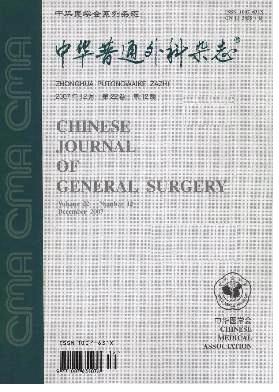Diagnosis and treatment of rare types of hepatic benign space occupying lesions
引用次数: 0
Abstract
Objective To summarize the experience of diagnosis and treatment of rare type of hepatic benign space occupying lesions. Methods The clinical data of 113 patients with rare type of hepatic benign space occupying lesions confirmed by surgery and pathology from Jan 2009 to Dec 2018 were retrospectively analyzed. Results There were 51 males and 62 females , age ranging from 12 to 83 years, with an average of 44.3 years. 91.2% of the 113 cases were single lesions and 8.8% were multiple lesions. Surgical methods included hepatectomy in 98 cases, ablation therapy in 12 cases and hepatectomy combined with ablation in 3 cases. There were 21 types of pathology in 113 patients. The top five types were focal nodular hyperplasia (30 cases), hepatocellular adenoma (16 cases), dysplasia nodules (14 cases), perivascular epithelioid cell tumors (12 cases), and mucinous cystic neoplasms (11 cases), accounting for 73.5% cases. All the patients were alive in the follow-up period ranging from 6 to 120 months. Conclusion Preoperative diagnosis of rare benign space-occupying lesions of the liver is very difficult. Preoperative MRI is helpful for diagnosis. Conservative treatment or follow-up observation can be considered for the type malignancy have never been reported. For the borderline types or those with difficulty in definite diagnosis, surgical removal is recommended. Key words: Liver neoplasms; Surgical procedures, operatives罕见型肝脏良性占位性病变的诊断与治疗
目的总结罕见型肝脏良性占位性病变的诊治经验。方法回顾性分析2009年1月至2018年12月经手术病理证实的113例罕见型肝脏良性占位性病变的临床资料。结果男51例,女62例,年龄12~83岁,平均44.3岁。113例中91.2%为单一病变,8.8%为多发病变。手术方法包括肝切除术98例,消融术12例,肝切除联合消融术3例。113例患者共有21种病理类型。前五种类型为局灶性结节性增生(30例)、肝细胞腺瘤(16例)、发育不良结节(14例)、血管周围上皮样细胞瘤(12例)和粘液性囊性肿瘤(11例),占73.5%。所有患者在随访6-120个月期间均存活。结论罕见肝脏良性占位性病变的术前诊断非常困难。术前MRI有助于诊断。对于从未报道过的恶性肿瘤类型,可以考虑保守治疗或随访观察。对于边缘型或难以明确诊断的患者,建议手术切除。关键词:肝肿瘤;手术程序、操作人员
本文章由计算机程序翻译,如有差异,请以英文原文为准。
求助全文
约1分钟内获得全文
求助全文

 求助内容:
求助内容: 应助结果提醒方式:
应助结果提醒方式:


